
Washington, D.C. — The United States Department of Energy (DOE) has announced a $1 billion collaboration with semiconductor giant Advanced Micro Devices (AMD) to build two state-of-the-art supercomputers designed to tackle some of the nation’s most complex scientific and security challenges.
According to Energy Secretary Chris Wright and AMD CEO Lisa Su, the systems — codenamed Lux and Discovery — will drive advancements in fields ranging from nuclear fusion research and national defense to cancer treatment and drug discovery.
The partnership underscores Washington’s commitment to maintaining global leadership in artificial intelligence (AI) and high-performance computing (HPC) at a time when international competition in the supercomputing sector is intensifying.
Revolutionizing Science and National Security
Energy Secretary Wright said the DOE’s collaboration with AMD represents “a generational leap” in the nation’s computational capability.
“These systems will supercharge advances in nuclear power, fusion energy, and national security technologies,” Wright told Reuters. “We’ll also accelerate drug discovery by simulating molecular interactions to treat complex diseases like cancer.”
He emphasized that supercomputing and AI integration will help scientists replicate and study fusion reactions, the same processes that power the sun, potentially paving the way for clean, limitless energy.
“We’ve made great progress, but to recreate the center of the sun on Earth requires computational power beyond anything we’ve ever had,” Wright said. “These AI-driven systems will allow us to achieve that in the next few years.”
In addition to advancing clean energy, the supercomputers will play a crucial role in managing the US nuclear arsenal, ensuring reliability and safety without the need for live testing.
Building ‘Lux’ and ‘Discovery’: The Future of US Supercomputing
The first system, Lux, is scheduled to come online within the next six months. Built around AMD’s MI355X AI accelerator chips, Lux will also include AMD’s latest central processing units (CPUs) and networking hardware.
The project is being jointly developed by AMD, Hewlett Packard Enterprise (HPE), Oracle Cloud Infrastructure, and Oak Ridge National Laboratory (ORNL) — the same facility that previously hosted Frontier, one of the world’s fastest supercomputers.
“Lux represents the fastest deployment of a system of this scale that I’ve ever seen,” said AMD CEO Lisa Su. “It shows the speed and agility needed to propel US AI innovation forward.”
According to ORNL Director Stephen Streiffer, Lux will deliver nearly three times the AI computing capacity of current-generation supercomputers.
The second machine, Discovery, is expected to begin construction in 2028 and go operational in 2029. It will be powered by AMD’s upcoming MI430 series chips, which merge traditional supercomputing features with advanced AI processing capabilities for hybrid scientific workloads.
Streiffer said Discovery would represent “a quantum leap in computational power,” although specific performance metrics are still being evaluated.
Public–Private Collaboration for Innovation
Under the terms of the agreement, the Department of Energy will host both systems, while AMD and its partners will provide the hardware, software, and capital investment. The two parties will share computing resources to accelerate breakthroughs in scientific research and defense innovation.
A DOE spokesperson said the initiative marks the first in a series of partnerships between US national laboratories and private industry designed to bolster America’s leadership in AI, quantum computing, and exascale research.
The systems are expected to support research across a variety of disciplines, including:
- Climate modeling and weather prediction
- Materials science and quantum chemistry
- Fusion plasma simulation
- Genomic sequencing and drug design
- Cybersecurity and weapons safety simulations
AMD’s Role in US AI Leadership
AMD’s partnership with the DOE strengthens its position in the high-performance computing market, traditionally dominated by rivals like NVIDIA and Intel. The company’s MI-series accelerators have gained traction in both commercial and government supercomputing projects for their efficiency in AI workloads.
AMD’s stock rose 0.7 percent as of 12:15 PM in New York (16:15 GMT), reflecting investor confidence in the company’s growing role in the AI hardware ecosystem.
“This partnership illustrates how AI and HPC are merging into a single innovation ecosystem,” said tech analyst Mark Keller. “AMD’s growing collaboration with US federal agencies could set the tone for future public-private AI initiatives.”
A Vision for the Future
Energy Secretary Wright concluded by saying he hopes the new computational power will “transform science and healthcare.”
“Within the next five to eight years,” Wright said, “I believe we can turn many types of cancer from terminal illnesses into manageable conditions through simulation-driven drug discovery.”
With Lux nearing completion and Discovery on the horizon, the DOE’s initiative with AMD signals a new era in AI-enabled scientific computing — one that could redefine the future of energy, medicine, and national defense.
Leave a Reply